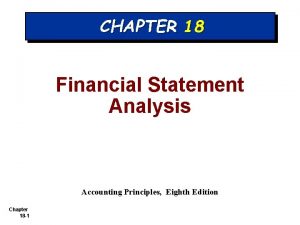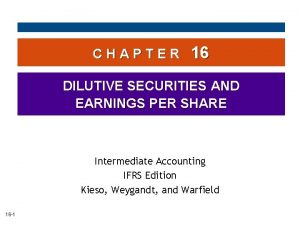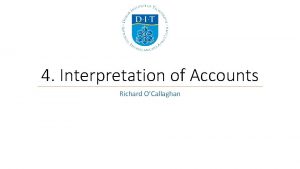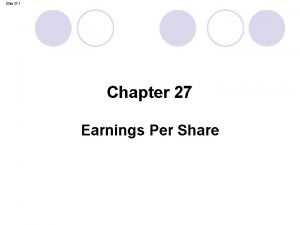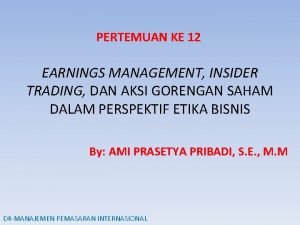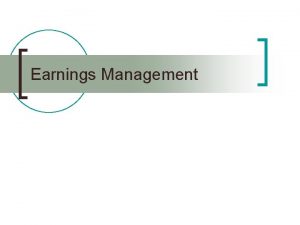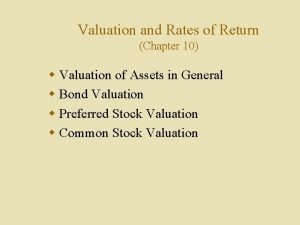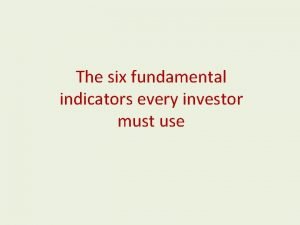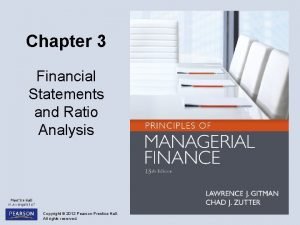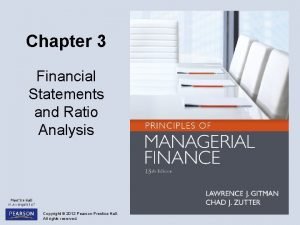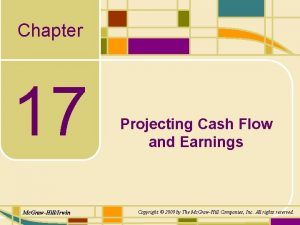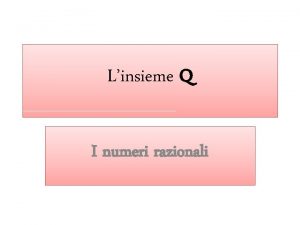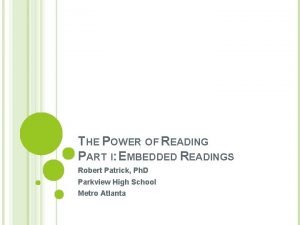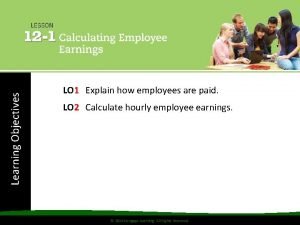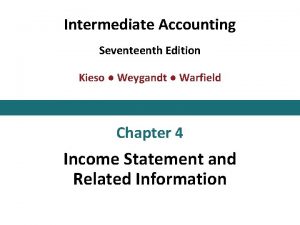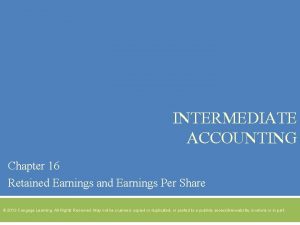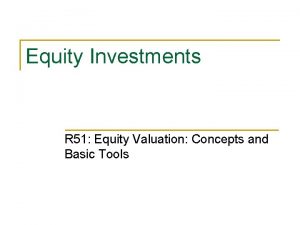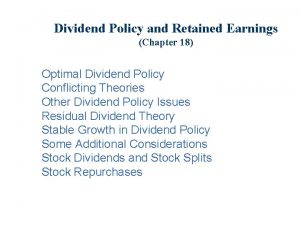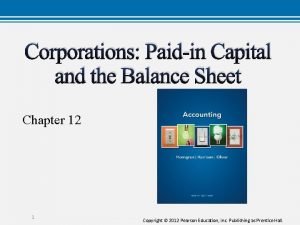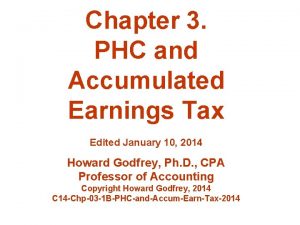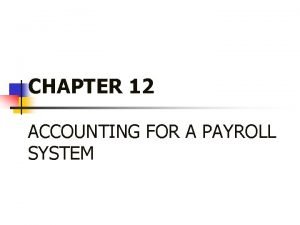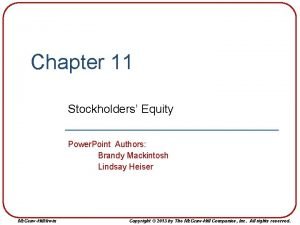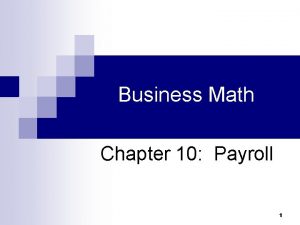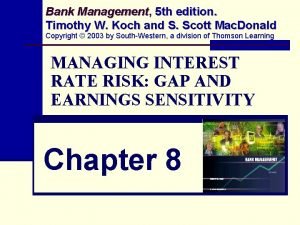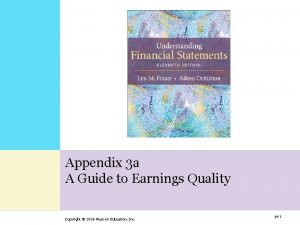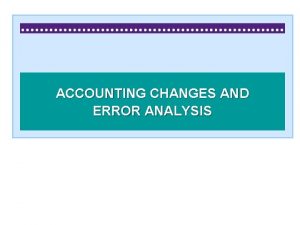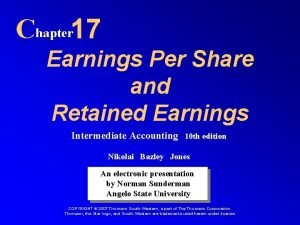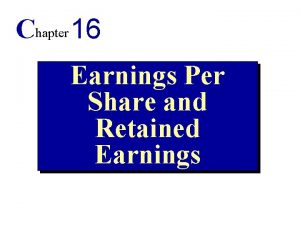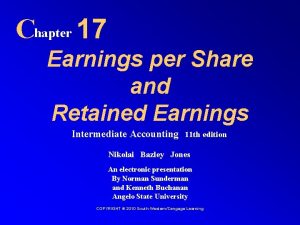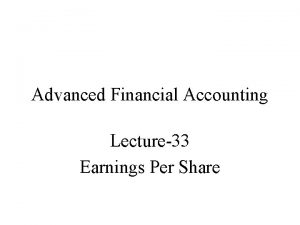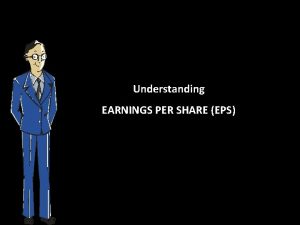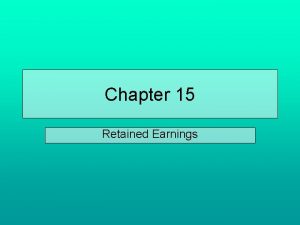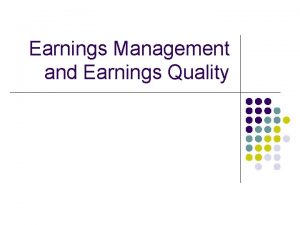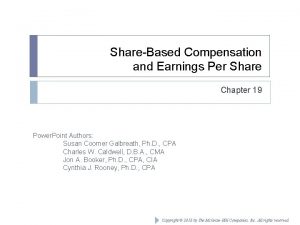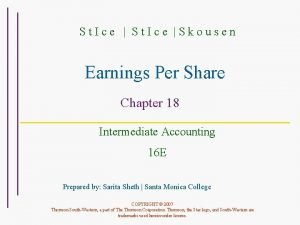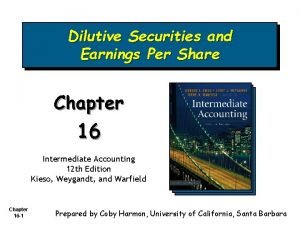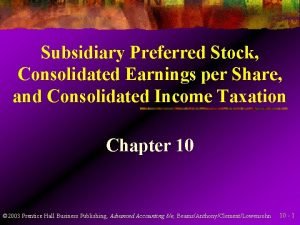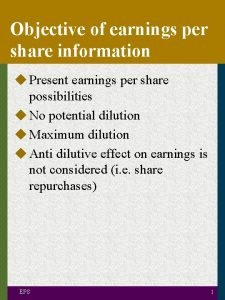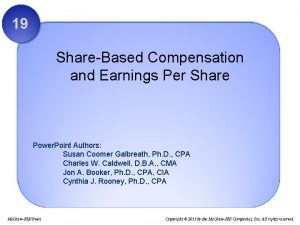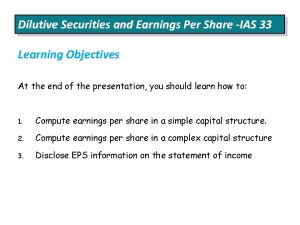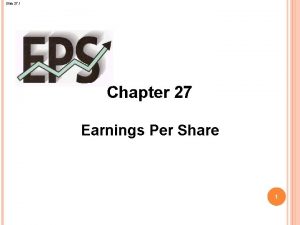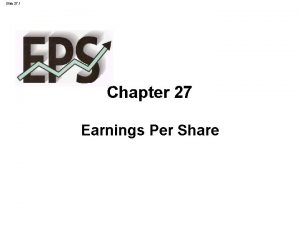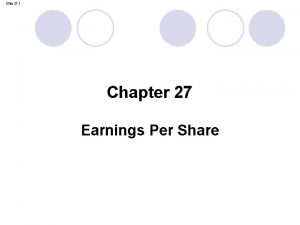Earnings per share Management Level Paper F 2











































- Slides: 43

Earnings per share Management Level – Paper F 2 Advanced Financial Reporting Lecture - 009 Vidya Rajawasam ACMA CGMA MBA

Earnings per share We have discussed the subject area related ØShare-based payments (IFRS 2) in our previous lecture.

Earnings per share v. In this lecture we will discuss the Earnings per share IAS 33

Earnings per share IAS 33 Earnings per share The EPS of an entity whose shares are publicly traded is regarded as a very important measure of performance. It is therefore important that EPS should be reported on a standard basis for all relevant companies.

Earnings per share IAS 33 lays down clear and generally accepted definitions and procedures for calculating EPS and applies to all entities whose ordinary shares or potential ordinary shares are publicly traded. The basic principle of EPS is to obtain a consistent and comparable ratio for measuring earnings.

Earnings per share IAS 33 Earnings per share (EPS) is an important ratio as it is one of the component parts of the Price/Earnings ratio (P/E ratio). The P/E ratio is used by investors to help them identify the relative riskiness of investments and the potential future performance of a business. This then allows an investor to see if investments are over-valued or under-valued by the stock market.

Earnings per share IAS 33 Earnings per share EPS is also considered important by investors, analysts and others as a key measurement of performance and as a basis for making decisions. It is principally for these reasons that some accounting standard setters, amongst them the IASB, have produced accounting standards regulating its calculation.

Earnings per share Basic earnings per share Basic EPS = profit attributable to the ordinary shareholder’s of the parent / weighted average number of ordinary shares in issue during the year The earnings per share figure is disclosed at the bottom of the statement of profit or loss.

Earnings per share Problems in arriving at the number of equity shares in issue Arriving at the number of equity shares in issue can present a problem if there is an issue of shares during the year. The following situations may arise: ● issue at full market price; ● bonus issue (also known as capitalization issue or scrip issue);

Earnings per share Problems in arriving at the number of equity shares in issue ● share exchange; ● rights issue. The key to understanding the calculations is to assess whether the change in share capital has increased the earnings potential of the entity.

Earnings per share Issue at full market price Where there is an issue at full market price, cash or other assets will flow into the entity – these will then generate earnings. In order to reflect this in the calculations, the earnings are apportioned over the average number of shares in issue and ranking for dividend during the period weighted on a time basis. .

Earnings per share Issue at full market price Example 1 A had four million ordinary shares in issue and ranking for dividend at 1 January 20 X 1. On 30 September, one million further shares were issued. Earnings for the year ended 31 December 20 X 1 were $500, 000. The number of shares would be time apportioned as follows: 1 Jan – 30 Sep: 4, 000 x 9/12 3, 000 30 Sep – 31 Dec: 5, 000 x 3/12 1, 250, 000 Weighted average number of shares 4, 250, 000 Earnings per share 500, 000/4, 250, 000 11. 8¢

Earnings per share Bonus issue In a bonus issue, no fresh capital enters the business and no further earnings are generated. The effect is merely to revise the number of shares in issue. We therefore use the number of shares ranking for dividend after the bonus issue. This can be done by multiplying the original share capital by the bonus factor. If the bonus issue is a 1 for 4, the bonus factor is 5/4. This is irrespective of the date when the bonus issue was made. The corresponding figures for all earlier periods are recalculated to include the bonus issue. This can be done by multiplying the corresponding EPS by the reciprocal of the bonus factor.

Earnings per share Bonus issue Example 2 B has four million ordinary shares in issue at 1 January 20 X 1. On 30 September the entity made a bonus issue of 1 for 4. Earnings for the year ended 31 December 20 X 1 were $500, 000. The EPS for 20 X 0 was 9 cents per share. The number of shares would be: 4000000 x 5/4 = 5, 000 EPS would be per share 500, 000 / 5, 000 = 10 cents per share.

Earnings per share Bonus issue Example 2 The EPS for the previous year’s comparative is restated using the bonus fraction: 20 X 0 EPS = 9 cents x 4 / 5 = 7. 2¢ per share

Earnings per share Review MCQs The basic principle of EPS is ? a) Disclosure requirements related to Equity. b) Understand the types of revenue generated by the organization. c) To obtain a consistent and comparable ratio for measuring earnings. d) Non of the above

Earnings per share Review MCQs The basic principle of EPS is ? a) Disclosure requirements related to Equity. b) Understand the types of revenue generated by the organization. c) To obtain a consistent and comparable ratio for measuring earnings. d) Non of the above

Earnings per share Review MCQs The Problems in arriving at the number of equity shares in issue is ? a) Due to a rights issue b) Over issue of shares c) Under issue of shares d) Non of the above

Earnings per share Review MCQs The Problems in arriving at the number of equity shares in issue is ? a) Due to a rights issue b) Over issue of shares c) Under issue of shares d) Non of the above

Earnings per share Share exchange Where shares (ranking for dividend) or loan stock have been issued during the year in consideration for shares in a new subsidiary, they are included in the weighting calculation as of the date on which the acquisition is recognized. In the calculation of EPS, this is treated as an issue at full market price. .

Earnings per share Rights issue A rights issue is an issue to existing shareholders, made at a price below current market price, to encourage shareholders to take up the shares. Cash is received into the entity to generate income, but not as much as an issue at full market price. Therefore a rights issue is a combination of an issue at full market price and a bonus issue.

Earnings per share Rights issue The calculation will have to reflect the bonus element of the rights issue; this is done by calculating t he bonus fraction a s follows: Bonus fraction = Fair value before the exercise of rights / Theoretical exrights price The numerator of the bonus fraction can be obtained from the share prices or is given in the examination question. The denominator is calculated as theoretical value of the shares after the issue.

Earnings per share Rights issue The bonus fraction is applied, as with a bonus issue, to all periods and will affect the number of shares prior to the issue and the corresponding year’s EPS. The other element of the rights issue, the issue at full market price, is reflected by calculating the weighted average number of shares on a time basis.

Earnings per share Rights issue Example 3 C had four million ordinary shares in issue and ranking for dividend at 1 January 20 X 1. On 30 September, a rights issue of 1 for 4 at 50 cents per share was made. The market price of the shares prior to the issue was $ 1 per share. Earnings for the year ended 31 December 20 X 1 were $500, 000. The EPS for 20 X 0 was 9 cents per share.

Earnings per share Rights issue Example 3 1. Calculate the price of the shares after the rights issue, theoretical ex-rights price*: $ If a shareholder had four shares at $1 per share 4. 00 They would be entitled to a further one share at 50¢ per share 0. 50 Holding after the rights issue five shares (at 90¢) 4. 50 * Note: This ex-rights price is theoretical. It may not be (and probably will not be) the same as the market price of the shares immediately after the rights issue.

Earnings per share Rights issue Example 3 2. The bon us fraction would be: Bonus fraction = Fair value before the exercise of rights / Theoretical exrights price 3. Calculate the weighted average number of shares: 1 J an– 30 Sep: ( 4, 000 x 100/90) x 9/12 3, 333 30 Sept– 31 Dec : 5 , 000 x 3/12 1, 250, 000 Weighted average number of shares 4, 583, 333

Earnings per share Rights issue Example 3 4. Calculate E PS: 500, 000 / 4, 583, 333 = 10. 9 ¢ 5. The EPS for the prior year comparative is restated using the inverse of the bonus fraction: 20 X 0 EPS = 9 cents x 9 / 10 = 8. 1¢ per share

Earnings per share Diluted earnings per share An entity may have in issue at the year end date a number of financial instruments that give rights to ordinary shares at a future date. These are referred to as potential ordinary shares in IAS 33. Examples of potential ordinary shares are: ● convertible debt or equity instruments; ● share warrants and options; ● rights granted under employee share schemes; ● contingently issuable shares, where the ordinary shares are issued upon completion of some contractual agreement.

Earnings per share Diluted earnings per share When the obligations are realized the number of ordinary shares will increase, therefore lowering the earnings per share. This is said to have a potential dilutive effect on EPS. Earnings can be affected in some cases and the diluted EPS is calculated using an adjusted profits figure. In order that users are informed of the potential ‘ dilution ’ of their earnings, IAS 33 requires that a diluted EPS is calculated.

Earnings per share Diluted earnings per share The diluted EPS ratio is: Earnings per basic EPS + Adjustment for dilutive potential ordinary shares / Number of shares per basic EPS + Adjustment for dilutive potential ordinary shares Potential ordinary shares are deemed to be converted to ordinary shares at the start of the period. Where the potential ordinary shares are issued during the period, they are taken from the date of issue of the financial instrument.

Earnings per share Diluted earnings per share Convertible financial instruments Where an entity has in issue at the year end date convertible loan stock or convertible preference shares they will affect the ratio as follows: ● Profits – There will be a saving of interest. Interest is a tax-deductible expense and so the post tax effects will be brought into the adjusted profits. – There will be a saving of preference dividend. There are no associated tax effects here.

Earnings per share Diluted earnings per share Convertible financial instruments ● The number of shares will increase. Where there is a choice of dates for conversion, IAS 33 assumes the most advantageous conversion rate or exercise price from the standpoint of the holder that is still available.

Earnings per share Convertible financial instruments Example 3 Throughout the year ended 31 December 20 X 3 A had in issue $2, 000 10% convertible loan stock. The terms of conversion for every $100 of loan stock are as follows: • 31 December 20 X 3 122 ordinary shares • 31 December 20 X 4 120 ordinary shares • 31 December 20 X 5 110 ordinary shares

Earnings per share Convertible financial instruments - Example 3 Throughout the year ended 31 December 20 X 3 A had in issue $2, 000 10% convertible loan stock. The terms of conversion for every $100 of loan stock are as follows: • 31 December 20 X 3 122 ordinary shares • 31 December 20 X 4 120 ordinary shares • 31 December 20 X 5 110 ordinary shares Profits attributable to ordinary shareholders for the year amounted to $25, 000. The weighted average number of shares in issue during the year was 100, 000. A paid tax at 33%.

Earnings per share Convertible financial instruments - Example 3 1. Adjust profits. $ Earnings Add net interest saved Interest ( 2 m x 10%) 200, 000 Taxation ( 200, 000 x 33%) (66, 000) 134, 000 Fully diluted earnings $ 25, 000 25, 134, 000

Earnings per share Convertible financial instruments - Example 3 1. Adjust profits. $ Earnings Add net interest saved Interest ( 2 m x 10%) 200, 000 Taxation ( 200, 000 x 33%) (66, 000) 134, 000 Fully diluted earnings $ 25, 000 25, 134, 000

Earnings per share Convertible financial instruments - Example 3 2. Adjust number of shares. The maximum number of shares that convertible loan stockholders could take up is 120 on 31 December 20 X 4. The 122 ordinary shares available at 31 December 20 X 3 would have already been taken up and so the next available time is the following year (120 shares available). Weighted average number of shares in issue 100, 000 Dilution ( 2, 000 x 120/100) 2, 400, 000 Fully diluted number of shares 102, 400, 000 Fully diluted EPS 24. 5¢

Earnings per share Review MCQs What is true related to a rights issue? a) Rights issues are always oversubscribed. b) Disclosure requirements are not required. c) A rights issue is an issue of shares to existing shareholders. d) Non of the above

Earnings per share Review MCQs What is true related to a rights issue? a) Rights issues are always oversubscribed. b) Disclosure requirements are not required. c) A rights issue is an issue of shares to existing shareholders. d) Non of the above

Earnings per share Review MCQs The Diluted earnings per share scenario results in due to ? a) Decrease in number of shares issued. b) Issue of share warrants and options c) Rights granted under employee share schemes d) Non of the above

Earnings per share Review MCQs The Diluted earnings per share scenario results in due to ? a) Decrease in number of shares issued. b) Issue of share warrants and options c) Rights granted under employee share schemes d) Non of the above

Earnings per share Lecture Summary Ø Earnings per share

Earnings per share Management Level – Paper F 2 Advanced Financial Reporting Lecture - 009 Vidya Rajawasam ACMA CGMA MBA
 4000000x5
4000000x5 Solvency ratio accounting
Solvency ratio accounting Chapter 16 dilutive securities and earnings per share
Chapter 16 dilutive securities and earnings per share Creditor days
Creditor days Walt disney company slogan
Walt disney company slogan Eps formula
Eps formula Insider trading adalah
Insider trading adalah Earnings management definition
Earnings management definition Preferred stock formula
Preferred stock formula Dividend per share example
Dividend per share example Intermediate accounting chapter 15
Intermediate accounting chapter 15 Bartlett company balance sheet
Bartlett company balance sheet Types of ratio analysis
Types of ratio analysis Cash flow per share
Cash flow per share Aice english paper 2
Aice english paper 2 General paper essay topics
General paper essay topics Moltiplicazioni con numeri periodici
Moltiplicazioni con numeri periodici Coop per te
Coop per te Mio diletto
Mio diletto Eina per ugni nedega
Eina per ugni nedega 27 miles per gallon into kilometers per liter
27 miles per gallon into kilometers per liter 1 minutes
1 minutes 1800 dam per jam berapa hm per menit
1800 dam per jam berapa hm per menit Per stirpes v per capita
Per stirpes v per capita Multas per gentes et multa per aequora vectus
Multas per gentes et multa per aequora vectus Longum iter est
Longum iter est Per capita vs per stirpes
Per capita vs per stirpes Catullus 84
Catullus 84 Long term sources of finance
Long term sources of finance Justified trailing p/e
Justified trailing p/e How does threegreen calculate overtime earnings?
How does threegreen calculate overtime earnings? Intermediate accounting
Intermediate accounting Intermediate accounting chapter 16
Intermediate accounting chapter 16 Revenue minus expenses equals
Revenue minus expenses equals Ev/ebitda ratio
Ev/ebitda ratio Retained earnings in accounting
Retained earnings in accounting Return on common stockholders' equity
Return on common stockholders' equity Accumulated earnings credit
Accumulated earnings credit Problem 12-1 calculating gross earnings
Problem 12-1 calculating gross earnings Par stock
Par stock Gross pay formula business math
Gross pay formula business math Earnings at risk
Earnings at risk Quality of earnings checklist
Quality of earnings checklist Accounting changes and error analysis
Accounting changes and error analysis

